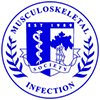Author(s): *Corey O. Montgomery, MD and Richard P. Evans, MD, Mark S. Smeltzer, PhD; University of Arkansas for Medical Sciences, Little Rock, Arkansas
Title: Treatment of Septic Total Knee and Hip Arthroplasty with Daptomycin Impregnated Polymethylmethacrylate (PMMA)
Purpose: To report the first five clinical cases of methicillin-resistant staphylococcal periprosthetic joint infection with the treatment combination of intravenous and daptomycin-impregnated PMMA implantation. Serum and joint daptomycin levels are reported.
Methods: Three total hip and two total knee arthroplasties with methicillin-resistant staphylococcal periprosthetic sepsis were treated with daptomycin-impregnated polymethylmethacrylate (PMMA) implantation. Two hips and one knee had previously failed two-stage treatment with vancomycin impregnated PMMA spacer implants. Four joints had mixed infections. Two patients were culture positive for vancomycin resistant Enterococcus (VRE) prior to transfer and treatment initiation. Debridement was followed by implantation of daptomycin impregnated Palacos PMMA. Four grams of daptomycin and four grams of tobramycin mixed per 40 g PMMA batch were used for implantation. Articulating PMMA spacer placement with two-stage replacement surgery was employed in four cases. One early infection underwent component retention, debridement and daptomycin PMMA bead implantation. Daptomycin 6 mg/kg q24h for 6 weeks was administered following the first stage debridement and implantation. Second-stage reconstruction was completed twelve weeks after first stage implantation. In the case of component retention PMMA beads were removed at two weeks. Renal indices, CBC, ESR and CRP were obtained serially during treatment. Surveillance was implemented for any unexplained signs and symptoms of myopathy. Daptomycin joint fluid and serum samples were collected during treatment. Joint fluid samples were obtained by drain sampling and joint aspiration. Levels were determined by pharmaceutical reference lab.
Results: Four of five patients with this treatment had successful control of infection and second stage revision joint replacement with a minimum one year follow-up. This group included three cases that had two-stage treatment with articulating PMMA spacer implantation. The fourth patient underwent treatment with intravenous and Daptomycin bead implantation with component retention. One patient with a mixed gram negative and MRSA infection was found to be clinically septic at the second stage but was culture negative. Daptomycin has in vitro bactericidal activity against methicillin-resistant Staphylococcus aureus (MRSA) and glycopeptide intermediate-resistant S. aureus (GISA). MIC90 values for staphylococci are g0.5 mcg/mL. Serum daptomycin levels at 6 mg/kg q24h ranged from 12 - 49 mcg/mL. Intraarticular daptomycin levels ranged from 25 - 886 mcg/ml and remained higher than therapeutic serum levels for up to four weeks post operatively. Joint Daptomycin levels averaged two to fourteen times greater than serum levels. Renal insufficiency was identified during treatment and required dosing frequency decrease to every other day. Creatinine returned to baseline after discontinuance of therapy. No symptoms of myopathy were identified.
Discussion: Augmentation with antibiotic-impregnated PMMA cement implantation has improved treatment outcomes of periprosthetic infection. Daptomycin is a newer antibiotic developed for treatment of infection with resistant organisms. Little is known about the clinical use of daptomycin PMMA implantation or its elution from PMMA. Daptomycin is exhibits rapid, concentration-dependent bactericidal activity in vitro against Gram-positive organisms including, but not limited to, methicillin-resistant and methicillin sensitive strains of Staphylococcus aureus, Staphylococcus haemolyticus, Staphylococcus epidermidis (MRS) and vancomycin-resistant Enterococcus (VRE). Intravenous daptomycin plus daptomycin impregnated PMMA implantation appears to provide an alternative treatment for periprosthetic sepsis with methicillin-resistant staphylococcal organisms. In these cases presented intravenous daptomycin plus daptomycin PMMA implantation provided a successful treatment alternative for periprosthetic joint infections with methicillin-resistant organisms where standard vancomycin therapy had failed. This is a treatment alternative that did not previously exist for cases that have failed standard vancomycin treatment.

